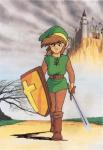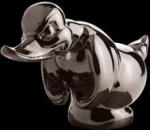1: The complexity of your dungeon
2: Your personal tolerance for insanity
If you've got something simple, planning can just about be thrown out the window. On the other hand, something really complicated might take a bit more forethought to prevent problems later on.
For almost all of my dungeons the planning process went something like this:
1) Determine the essentials; whats the shape of the dungeon, whats the theme, what item/s will be found there, what boss will you fight there,etc.. With the exception of shape, I plotted most of that down prior to making the first dungeon.
2) Shape the dungeon in Zqwest. Go in and plop down all the rooms in the dungeon.
3) Look at an overview of the dungeon and ask myself 'how do I want players to go through the dungeon?' Make a mental path of where you want the player to go, and what rooms they have to go through to get there. This also involves designating 'important' rooms, i.e. boss/triforce rooms, entrance, item rooms, and any other specific rooms I want to make sure I include in the dungeon.
3.5) If my plan gets particularly complicated, I draw up a map of my dungeon, (or better yet, since the dungeons already shaped, take a snapshot in zqwest and print it out.) Having a paper map makes referencing and planning much easier for me. It's also useful later when I need to recall any details I've forgotten; its easier to look on a paper than to hunt through zqwest to find something out.
4) "Path" the dungeon. Go through and plan out and then put in all the doors/stairs/warps in the dungeon. During this time, I also put in all the locked doors, and all the keys.
5) Test the dungeon. Make sure the plan works, before making the dungeon hard to navigate. Walk the dungeon in game and make sure all the doors can be opened, and look for unintended shortcuts, or places where shortcuts might be needed.
6) Go through and build each room of the dungeon, placing terrain/traps/secrets. This is mostly done on the fly, save when I already have an idea for that room.
7) Test the dungeon again, making sure all the secrets work correctly
9) Test again for difficulty, make sure the room is as difficult as intended
10) Polish the dungeon and make another complete run through the dungeon, with a character geared for that dungeons level.
11) Send it to a friend for another set of opinions. A third party player who's not familiar with your dungeon is more likely to find flaws in the design
12) repeat 10 and 11 until the dungeon is satisfactory
I suppose the key is testing the dungeon. Test early, test often. Don't wait until everything's in place to realize "oh no, I need a key, but I can't get to them"'. Personally, I prefer the general planning method as a way to prevent making something unsolvable (isn't that why you're planning it in the first place?) Honestly, I couldn't imagine 'winging' some of the dungeons I made, as it would drive me crazy trying to remember where everything goes, but on the other hand, planning every detail out before hand would be so tedious to me that I would give up on it before anything substantial got planned.
But really, you have to wing it while your planning it the first time, so I guess the only real difference lies with the maker, those with the mind to see how it works on paper vs. someone who can see it as they make it.
Edited by Xiion, 25 February 2008 - 12:00 AM.







